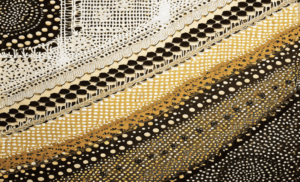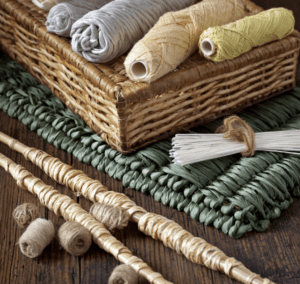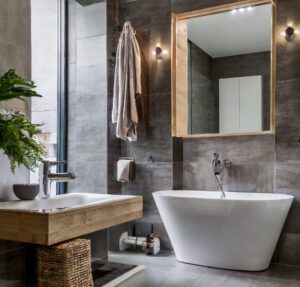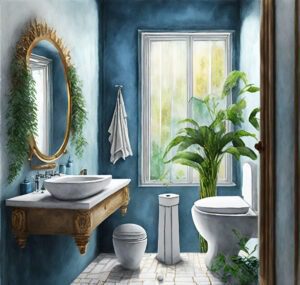Introduction of towel weaves
The term “weaves” describes the manner that threads are woven together to make fabric. It is the structure and pattern created by the loom’s weft and warp threads crossing one another horizontally. Fabrics with different weaves have different looks, textures, and strengths. A few popular weave varieties are satin, twill, plain, and intricate weaves like dobby and jacquard. Every weave is different and can be used for a variety of projects, from making exquisite satin fabrics to robust denim (twill). In textile manufacture, knowing weaves is essential since they affect the fabric’s overall appearance, durability, and qualities. The world of towel weaves is surprisingly large and interesting, providing a pleasant combination of practicality and style.

Twill and waffle weaves
Twill weave
The surface of the cloth has diagonal lines or ribs that are immediately identifiable as twill weave. In order to create diagonal ridges or lines across the material, the warp and weft threads are interlaced in a certain pattern. Frequently, this weave produces a strong, resilient fabric that is renowned for its tenacity. One popular twill weave fabric that is valued for its longevity and unique diagonal pattern is denim.

Waffle weave
Its name comes from the textured surface of waffle weave, which is similar to a waffle grid. Raised squares or cells resembling honeycomb are woven throughout the cloth in this pattern. It is a well-liked option for blankets, bathrobes, and towels due to its great absorption capacity and rapid drying speed. With more surface area due to the waffle structure, the fabric can absorb moisture better while still being lightweight. As a summary, waffle weaves have a textured grid-like design and are excellent at quick drying, while twill weaves feature diagonal patterns and are more durable. Because of their distinctive characteristics, both weaves can be used in a variety of ways in the textile industryThe sophisticated weaving techniques produce the distinctive waffle weave design. Many techniques, such as certain fabric mixes and dobby looms, are used to produce waffle weaves, enabling the fabrication of a variety of textures and patterns. Numerous goods, including clothes, accessories, and linens for the house, use the incredibly versatile waffle weave.They are perfect for clothes, towels, and blankets since they allow in air while retaining warmth. These products have an attractive appearance and feel thanks to their rough surface.

Spot weaves
Create fabrics with discrete spots or dots scattered throughout the cloth to create spot weaves, also called dotted weaves. Textiles that are both adaptable and aesthetically pleasing might result from the variation of these spots in terms of size, density, and arrangement. Among the unique qualities of spot weaves are their capacity to produce textured surfaces, experiment with contrast, and have a distinctive aesthetic appeal. A creative touch is added to the fabric by the spots’ asymmetrical distribution. Spot weaves are used throughout a range of industries, from traditional apparel to contemporary home décor.They adorn upholstery, fashion garments, and even technical textiles, showcasing their adaptability. Spot weaves offer unique textural qualities, allow for creative designs, and possess a versatile nature that adapts well to various applications. This weaving technique intricately places varied-sized spots in diverse densities and arrangements, resulting in a visually striking texture. It’s this irregular and creative distribution of spots that sets spot weaves apart, infusing fabrics with a unique, artistic appeal that lends itself well to a myriad of applications across fashion, interior design, and beyond.

Lace weaves
With their elaborate and delicate designs, lace weaves are evocative of needlework. Due to the careful weaving techniques used in their manufacture, these weaves include broad voids that frequently mimic net-like structures. Their elaborate patterns, deft designs, and creative use of positive and negative space are what distinguish lace weaves. From floral motifs to geometric shapes, these designs provide an abundance of creative choices. From interior design to haute couture, lace weaves have influenced a wide range of sectors. Beautiful bridal gowns, opulent house furniture, and architectural details are all frequently adorned with their exquisite workmanship and elegance.Despite their beauty, lace weaves can be delicate and complex to create, requiring expert workmanship. Furthermore, because of their sensitive nature, they might not be appropriate for every application. Spot weaves, sometimes called dotted weaves, are a unique technique for creating textiles in which individual spots or dots are incorporated into the fabric. This weaving method creates a texture that is visually arresting by carefully placing different-sized spots in different densities and combinations. Spot weaves are distinguished by the innovative and asymmetrical arrangement of their spots, which endows materials with a certain aesthetic appeal that finds wide-ranging uses in the fashion and interior design industries, among other domains.

Supplementary warp and weft weaves
Supplementary warp weaves
The intricate tapestry of customs and artistic talent seen in supplemental warp weaves spans many civilizations and historical periods. The artistry of these exquisite weavers is a testament to their talent and the cultural legacy they uphold. It’s impossible to resist their allure. Rich brocades, graceful damasks, and opulent lampas are only a few examples of the many manifestations of these weaves, each with a convoluted past. They are both very innovative and firmly rooted in tradition; they are the outcome of arduous processes that have been handed down through the ages. The process that produced these artistic works was tedious and required a high level of skill. Textiles with exquisite designs and creative attributes are distinctive and visually captivating.In today’s fast-paced world, where ingenuity is the driving force behind evolution, supplementary warp weaves have changed. They end up in the hands of modern designers and craftspeople who fuse avant-garde aesthetic choices with historical references. Moreover, the emphasis on sustainability has led to innovative techniques that transform these weaves into eco-friendly choices in addition to stylish pieces. Despite their timeless appeal, these weaves nonetheless face challenges like as upholding traditional practices and adapting to changing market situations. However, attempts are being made to find solutions in order to maintain the lifespan of this skill and its cultural significance. Extra warp weaves have useful purposes beyond aesthetics. They transmit stories, act as a bridge between cultures, and provide assistance.

Weft weaves
. The focus here lies on the weft and its pivotal role in shaping textiles.Plain weave: This classic weave involves a simple over-under pattern, resulting in a balanced, strong fabric. Weft weaves exhibit various traits influencing their applications. Strength, appearance, and adaptability make them highly sought after in diverse industries.

Deflected double weaves
In today’s fast-paced world, where ingenuity is the driving force behind evolution, supplementary warp weaves have changed. They end up in the hands of modern designers and craftspeople who fuse avant-garde aesthetic choices with historical references. Moreover, the emphasis on sustainability has led to innovative techniques that transform these weaves into eco-friendly choices in addition to stylish pieces. Despite their timeless appeal, these weaves nonetheless face challenges like as upholding traditional practices and adapting to changing market situations. However, attempts are being made to find solutions in order to maintain the lifespan of this skill and its cultural significance. Extra warp weaves have useful purposes beyond aesthetics. They transmit stories, act as a bridge between cultures, and provide assistance.
.Starting from setting up the loom to weaving the threads, a comprehensive guide for beginners to create their first deflected double weave fabric. The versatility of deflected double weaves finds its place in haute couture, creating unique and luxurious fabrics for designer collections. . Diving into the myriad of patterns and designs achievable through deflected double weaves, showcasing the diversity and creativity this technique offers.


























